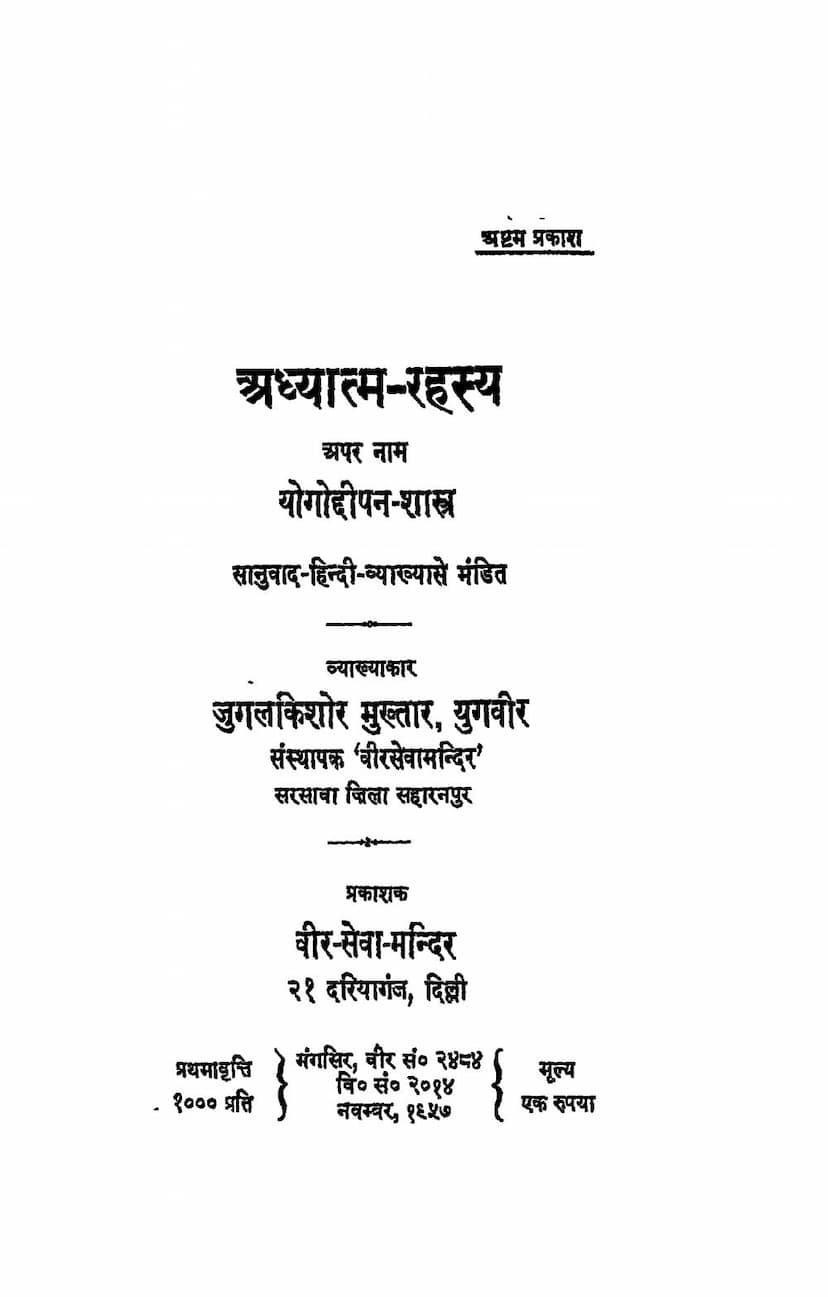Adhyatma Rahasya
Added to library: September 1, 2025

Summary
This is a comprehensive summary of the Jain text "Adhyatma Rahasya" by Jugalkishor Mukhtar, published by Veer Seva Mandir Trust:
Book Title: Adhyatma Rahasya (Spiritual Secret) Also Known As: Yogoddipana Shastra (Science of Yoga Awakening) Author: Pandit Ashadharji (as the original author of the text) Commentator/Translator: Jugalkishor Mukhtar (Yugveer) Publisher: Veer Seva Mandir Trust, Delhi Publication Date: First Edition - November 1957 (Mangshir, Vir Samvat 2484)
Overall Summary:
"Adhyatma Rahasya" is a profound Jain text attributed to the renowned scholar Pandit Ashadharji, who lived over 700 years before this publication. The book, previously considered lost or unavailable, was rediscovered in an old manuscript in Ajmer. This edition is a Hindi translation and commentary by Jugalkishor Mukhtar, aiming to shed light on the deep spiritual secrets of the soul and its connection with the divine, particularly through the path of Yoga.
Key Aspects and Themes:
-
Rediscovery and Significance: The book highlights the rarity and importance of the text, which was found after extensive searching. Its rediscovery is considered a significant event for the Jain community, making a valuable ancient scripture accessible.
-
Authorship and Lineage: The text is attributed to Pandit Ashadharji, a prolific Jain scholar. It was originally conceived as the 18th chapter of his larger work, "Dharmamrita," but later gained recognition as an independent treatise. The commentary acknowledges the scholarly tradition and the insights of previous Acharyas.
-
The Nature of Spirituality and Yoga: The core subject matter revolves around "Adhyatma" (Spirituality) and "Rahasya" (Secret), specifically focusing on the spiritual journey and the practice of Yoga. The other title, "Yogoddipana Shastra," emphasizes its role in awakening and invigorating spiritual practice.
-
The Soul (Atman) and its States: The text elaborates on the soul's journey through different states:
- Bahiratma (External Soul): The soul identified with the body and senses, unaware of its true nature, leading to suffering.
- Antaratma (Internal Soul): The soul that recognizes its distinctness from the body and senses, gaining knowledge and self-awareness but not yet full liberation.
- Paramatma (Supreme Soul): The fully realized, liberated soul, characterized by complete knowledge, bliss, and spiritual perfection. The book uses terms like "Swatma" (own soul), "Shuddha Swatma" (pure own soul), and "Parabrahm" (Supreme Soul) to denote these states, emphasizing the soul's individual and distinct existence.
-
The "So'ham" Meditation: A significant practice discussed is the meditation on "So'ham" (I am That), a subtle mantra used to connect the individual soul with the Supreme Soul. This practice aims to cultivate the realization of oneness and spiritual growth.
-
Comparison with Vedanta: The commentary draws parallels and distinctions between Jain philosophy and Vedanta, particularly concerning the concept of "Brahman." While Vedanta describes Brahman as Sat-Chit-Ananda (Existence-Consciousness-Bliss) and often as Nirguna (without attributes), the Jain perspective emphasizes the soul's inherent possession of these qualities as integral to its nature, not as something externally added or as a formless, attributeless entity. The Jain view of "Advaita" (non-duality) is nuanced, focusing on the non-separation of attributes from the soul rather than the non-existence of distinct entities.
-
The Three Pillars of Liberation (Ratnatraya): The path to liberation is presented through the "three jewels":
- Samyak Darshan (Right Faith): Correct perception and belief in the true nature of reality.
- Samyak Jnana (Right Knowledge): Accurate understanding of the soul and the universe.
- Samyak Charitra (Right Conduct): Virtuous behavior and spiritual discipline. These are discussed from both "Vyavahara Naya" (conventional/practical truth) and "Nischaya Naya" (ultimate/essential truth) perspectives.
-
Spiritual Practices and Obstacles: The text details practices like meditation (Dhyana), the nature of the senses, and the role of a true Guru. It also identifies obstacles to spiritual growth, primarily Rag, Dwesh, and Moh (attachment, aversion, and delusion), which are described as enemies of the soul. The overcoming of these obstacles through practices like equanimity (Samya) and dispassion (Vairagya) is crucial.
-
Karma and Its Liberation: The book touches upon the different types of karma – Bhava Karma (psychic karma), Dravya Karma (material karma), and Nokarma (quasi-karma or physical manifestations) – and the process of their shedding (Nirjara) and prevention (Samvara) through spiritual effort.
-
The Essence of "I Am That": The commentary deeply explores the meaning of "So'ham," clarifying that it refers to the soul realizing its own inherent qualities of existence, consciousness, and bliss, which are identical to the qualities of the Supreme Soul. The goal is to purify the soul's consciousness to reflect its true, inherent nature.
-
Commentary Style: Jugalkishor Mukhtar's commentary is detailed and explanatory, breaking down the verses of Ashadharji, providing philosophical context, comparing views, and citing other relevant Jain scriptures to elucidate the concepts. The commentary aims to make the profound ideas accessible to the reader.
In essence, "Adhyatma Rahasya" is a guide to understanding the true nature of the soul, its potential for spiritual realization, and the path of Yoga as a means to achieve liberation. It emphasizes self-awareness, detachment from worldly desires, and the cultivation of divine qualities within oneself.